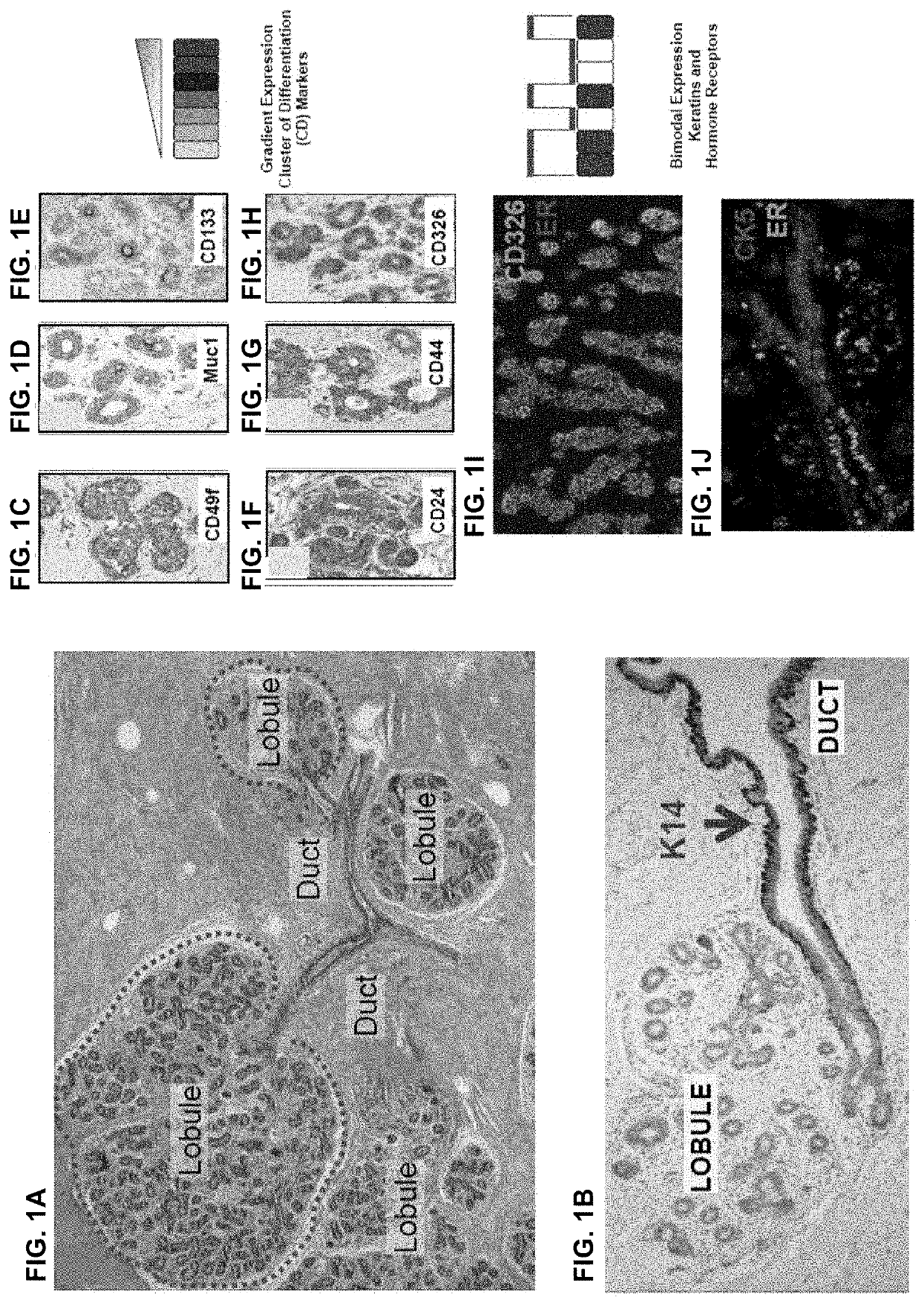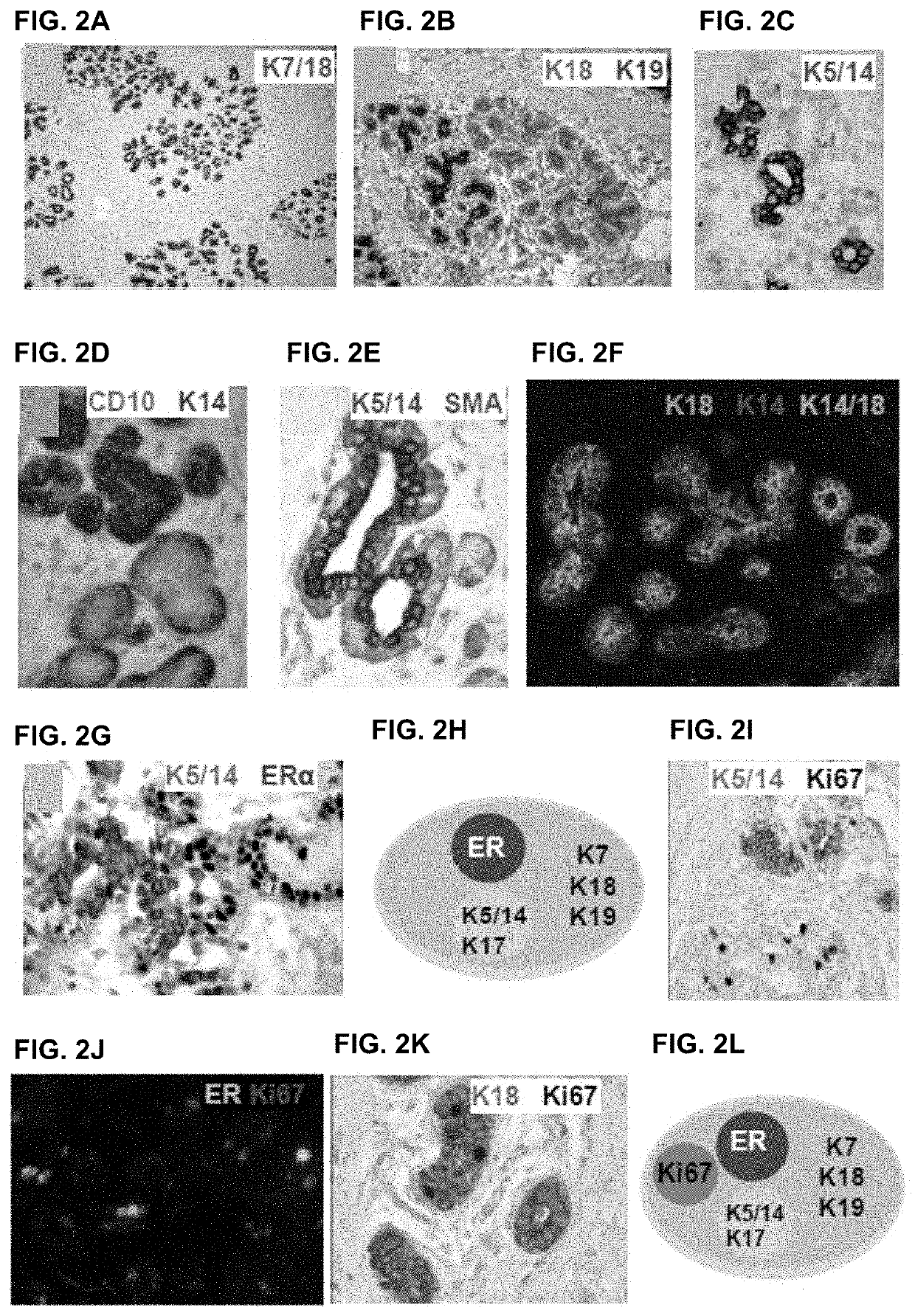Treating breast cancer with hormone receptor modulators
a hormone receptor and breast cancer technology, applied in the field of disease classification, can solve the problems of limited understanding of the cell types comprising the breast ducts, development of a normal cell type-based classification system, and misconception of ductal and lobular breast cancer, so as to improve the understanding and treatment of breast cancer, and achieve the effect of strong foundation for breast cancer medicin
- Summary
- Abstract
- Description
- Claims
- Application Information
AI Technical Summary
Benefits of technology
Problems solved by technology
Method used
Image
Examples
example 1
of Cluster of Differentiation (CD) Markers in Normal Human Breast
[0118]As noted previously, normal human breast is composed of milk producing lobules and interlobular ducts that transport the milk to the nipple (FIG. 1A). The vast majority of human breast tumors are classified on morphological grounds either as ‘ductal carcinomas” or as ‘lobular carcinomas’, resulting in a common misconception that ductal and lobular breast cancers initiate in the normal ducts and lobules, respectively. However, despite their names, almost all of the early progression steps for both tumor types almost exclusively involve the breast lobules. Thus, the normal cells in the lobules were examined using immnunohistochemical (IHC) staining that preserves tissue architecture and allows discrimination of ducts, lobules and different layers of the epithelium. However, most proteins are expressed in a gradient pattern in vivo which limits their utility to define cell subtypes using semi-quantitative methods su...
example 2
of Intermediate Filaments in Normal Human Breast
[0119]In an attempt to identify molecules with bimodal expression patterns in normal human breast, the expression of intermediate filaments was examined since these molecules are differentially expressed in distinct cell types and their expression is both tissue and cell-type specific. Furthermore, it has been well recognized that the cell-type specific expression of intermediate filaments is preserved in tumors (10). For this reason, they have been successfully utilized by embryologists to study tissue differentiation and by pathologists to determine the tissue origin of tumors (11). A subset useful in identifying subpopulations of human breast cells was discovered which expressed in a bi-modal pattern. These included K5, 7, 8, 14, 17, 18, and 19 (FIG. 1J).
[0120]Next, normal breast tissues from 36 breast reduction mammoplasty procedures was examined, including 12 full FFPE sections and a tissue microarray with samples from 24 patients...
example 3
of Hormone Receptors in Normal Human Breast
[0126]Having identified two subtypes of luminal layer cells based on K5 / 14 / 17 expression, the expression of hormone receptors in these cells was characterized (15). Hormone receptors represent an appealing set of markers because they are intimately involved in regulation of tissue differentiation and some hormone receptors have a bi-modal expression pattern.
[0127]In an initial survey of the previously published studies and preliminary immunostains, three receptors including the estrogen receptor (ER), androgen receptor (AR) and vitamin D receptor (VDR) stood out with a distinct bi-modal expression pattern in luminal layer of the lobules (strong expression in some cells while other cells have no expression). Many of the other hormone receptors did not appear to have a bi-modal expression pattern (TRH α / βPTH1R, OXTR, SSTR1-3,5, RAR α / β, and RXR α / β. Thus, these other receptors did not appear promising as potential bimodal markers to identify ...
PUM
| Property | Measurement | Unit |
|---|---|---|
| Time | aaaaa | aaaaa |
| Time | aaaaa | aaaaa |
| Chemical shift | aaaaa | aaaaa |
Abstract
Description
Claims
Application Information
 Login to View More
Login to View More - R&D
- Intellectual Property
- Life Sciences
- Materials
- Tech Scout
- Unparalleled Data Quality
- Higher Quality Content
- 60% Fewer Hallucinations
Browse by: Latest US Patents, China's latest patents, Technical Efficacy Thesaurus, Application Domain, Technology Topic, Popular Technical Reports.
© 2025 PatSnap. All rights reserved.Legal|Privacy policy|Modern Slavery Act Transparency Statement|Sitemap|About US| Contact US: help@patsnap.com



